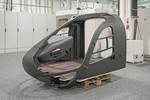Venox launches V-REX continuous fiber extrusion printer
Five-axis system with an automatic toolchanger achieves precise fiber placement for anisotropic properties, enables the use of up to six different print heads.
. Source | Venox Systems
After two years of development, (Lingenau, Austria) a tech startup specializing in additive manufacturing (AM) with continuous carbon fiber, is launching its latest 3D printer V-REX — an acronym for “Venox Revolutionary Extrusion System” — for industry and R&D.
To make optimal use of continuous fiber material properties, V-REX offers a five-axis system to enable precise placing of materials (like continuous carbon fiber) along the fiber direction, resulting in high-performance anisotropic components. Notably, the printer’s five axes now offer engineers complete design for any component. Another feature is V-REX’s automatic toolchanger, which makes it possible to use up to six different print heads in one process, increasing the manufacturing depth and complexity of components.
Five-axis XYZ travel paths are 600, 400 and 500 mm, respectively. A-axis runs +180-180° and the C-axis runs 360°. Three-axis printing volume XYZ travels are 600, 400 and 400 mm, respectively. Print heads for continuous fibers and thermoplastic materials are capable of temperatures up to 500°C.
A crucial milestone in the development of the V-REX was the PreSeed DeepTech funding from the Austria Wirtschaftsservice GmbH (AWS, Vienna, Austria), which was specifically provided for the development of a five-axis continuous fiber print head. The AWS grant is only given to companies that focus on high technological challenges.
Related Content
-
Multi-material, self-sensing, 3D-printed scoliosis braces
Startup Fited and Brightlands Materials Center have developed a lighter weight, thinner CFRP corrective brace, including pressure sensors made from continuous carbon fibers.
-
Al Seer Marine, Abu Dhabi Maritime unveil world’s largest 3D-printed boat
Holding the new Guinness World Record at 11.98 meters, the 3D-printed composite water taxi used a CEAD Flexbot to print two hulls in less than 12 days.
-
Optimizing a CFRP landing leg demonstrator
MT Aerospace achieves design for manufacturing, integrating multiple elements into one-piece structure using AFP and 3D printed tooling to meet time and budget constraints.



